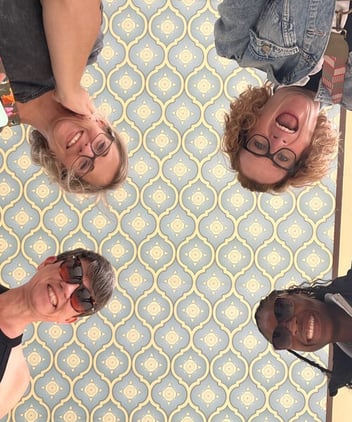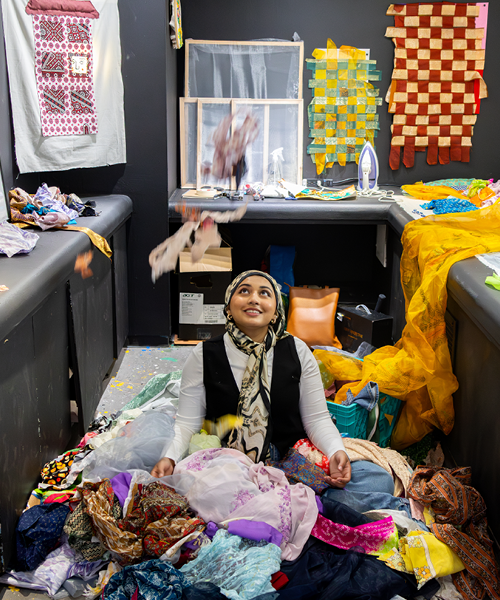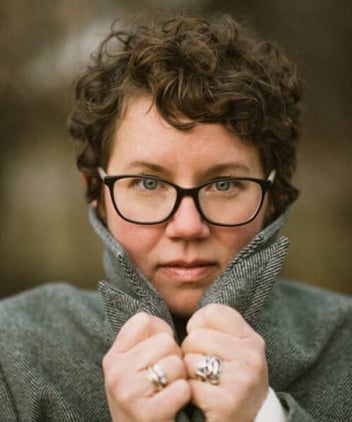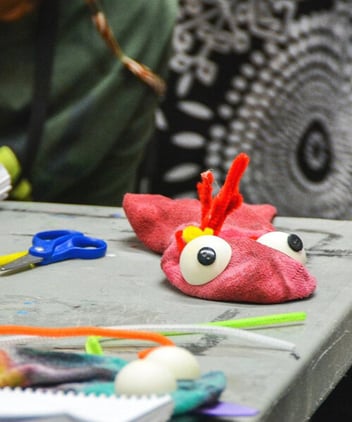
Over a century ago, my people settled on the banks of the North Saskatchewan River in Treaty 6 Territory, the traditional lands of the Cree, Saulteaux, Blackfoot, Dene, and Nakota Sioux. My paternal grandmother, Baba Nina Burima née Postnikoff, was a Doukhobor, or spirit wrestler; a Russian religious and ethnic group that left Russia in 1899 to escape centuries of torture, imprisonment, and dispossession at the hands of Tsarist regimes. Known for their diversity of progressive beliefs around pacifism, gender equality, animal rights, collective communal care and land stewardship, roughly 8,000 Doukhobors immigrated to Canada in 1899 and settled on Treaty 6 land that was to become the province of Saskatchewan in 1905. My ancestors survived their first winters living in homes they dug out in the riverbanks. The Burima family farm was 5 km from what is now the Doukhobor Dugout House National Historic Site, which has been preserved and celebrated through the tireless work and dedication of Doukhobor descendant Brenda Cheveldayoff.
My Baba is within me and all around me to this day. I see her in the mirror with the shape of my eyes and feel her on the piano keys in the curve of my fingers. I invoke her protection in my morning prayers and remind myself daily that I am made of stronger stuff than I realize. All of us are. If we are here, we are defined by the strength and determination of our ancestors. We are the embodied truth that the movement of migration defines humanity’s existence. When I think of my heritage, it’s these spirit wrestlers that I petition, who laid claim to their desire to know their God personally and without intermediary. This ancestral line speaks and travels through me to my daughter and will continue after I am gone from this earth.
Welcome to Why We Create, an ongoing collaboration and partnership with Arts Commons that endeavours to explore the creative processes of artists working in Alberta. My name is Kenna Burima, musician, songwriter, producer, educator, and writer. I am also a lover and cheerleader of artists.
The first time I saw Pakistani-Canadian artist Haniyyah Khan, her head was bent over a small piece of paper, gracefully brushing light brown paint in thin, intricate lines. I recall pausing at the window of the Lightbox Studio on the main level of Arts Commons on my way to a show at the Jack Singer Concert Hall, mesmerized by her work and the materials around her. As a mixed-media artist, Haniyyah uses printmaking, textiles, drawing, collage and film to explore themes of heritage and belonging. The second time I met her, we were shaking hands and sharing a laugh at a Founders Circle dinner this past spring. But it wasn’t until we sat down to talk officially about our heritage, and the concept of migration, that I knitted these together in an aha! moment and our shared love of collages and community came together in an intricate craft of connection.
“When I started, I had to search for what I connected to in my ancestry,” admits Haniyyah. “As a craft-based artist, my ancestry speaks through my work. Sculpture, textile, and fabric making are a really big part of our culture. And as I formulated my own perspective, I found my chance to speak about things that were personal to me through my creativity that was different from my peers.”
Hanniyah’s current exhibition, Finding Space, in the Lightbox Studio "explores the evolving relationship between body and space, using textiles as a metaphor for transformation...Through fabric-based works, print, and sculpture, this exhibition repurposes discarded materials to challenge ideas of value and permanence."
 Haniyyah Khan in the Lightbox Studio at Arts Commons. Photo: Dena Vahle
Haniyyah Khan in the Lightbox Studio at Arts Commons. Photo: Dena Vahle
“I took the pictures of me as a little kid when my parents immigrated from America to Canada,” says Haniyyah. “I looked at these pictures and asked how did I find my footing? Because we just got up and left, and I was like, ‘oh, cool snow!’ but I didn't know I'd be living there. It didn't hit me until much later, but I'm a result of immigration, and the story of how we migrated from Iran to India, to Pakistan, and then to Dubai, to America, and then finally to Canada, it’s made me who I am.”
The very act of survival of our species is through migration. And though it has always been a political act, it has been in recent years weaponized and politicized past the point of necessity and understanding. Our movement across all boundaries, be they walls, fences, or borders, is how we survive. It is what makes the construction of our country what it is and who we are as Canadians. When I ponder the word “heritage,” I am immersed not only in the concept of movement but also in the intersections of what and who was already there and what and who is being created; the relationship between the First Peoples and settlers and the relationship between materials and an artist’s inspiration to create something new.
As Haniyyah’s and my conversation continued, I was struck by how similar our artistic practices actually were. The idea of creating with something that already exists was a powerful reminder of my own project, Spirit Wrestler, a collection of songs I am currently writing in collaboration with my ancestors through engaging in the extensive Doukhobor song archives found at Doukhobor Songs Library and Doukhobor Music. As my ancestors orally transmitted teachings and traditions through their songs, I, as a descendant, have a wealth of material that I can pull from in my own songwriting process. Haniyyah’s process is similar, utilizing and recycling any material that she feels pulled to.
“For me, I think tangible is one of the words I use a lot when I talk about what I do, particularly collage," admits Haniyyah. “I take something that exists already and then I merge it with something else. I’ve also discovered and been playing around with printmaking and using block printing to create something. I had never done it before, so it was something new. Ajrak is a unique block-printed textile from Sindh, Pakistan, and India. It’s a tradition I felt most connected to, a part of my family’s heritage. I love the idea of embellishing things that we see every day, or we use every day.”
Doukhobors had a song for everything: births, deaths, farm work, animals, and baking bread. In a way, music was the embellishment for life embedded within the Doukhobor slogan “toil and a peaceful life.” Singing songs at every moment of mundanity offered a picture or a window into a moment of everyday life for Doukhobors that were then passed down through the generations. Windows also factor heavily into Haniyyah’s current artistic process and exhibition, certainly as the artist-in-residence for the Lightbox Studio, which is itself a window into a small room. Haniyyah works as the artist in the window.
“Currently, I am wondering what exists behind a window,” shares Haniyyah. “It can show a moment in time, and though it may always be the same home, same family, we're constantly going through change, whether it's physically, mentally, or emotionally. From moment to moment, we are in a different space. I wanted to highlight something that happens in a window that is true to where I come from. Maybe it’s people eating, or a bunch of people gathered, or children playing. Just looking through a window can give you an immediate sense of community. You can tell so much from a moment of where we are with our lives and how we interact with our families.”
The strong sense of community and love of family factors heavily into Haniyyah’s next adventure as she wraps up her Arts Commons residency and heads to the US for a Master’s in Landscape Architecture at UC Berkeley. The grit and determination that is required to follow your dreams as a person of colour are threads that Hanniyah is pulling now, and though she acknowledges the challenges ahead, she feels she owes it to those who came before her.
“I know the political climate is not really fun right now, but as our ancestors did, you have to follow your dreams. I think community is something that really pulls on me, and if my ancestors could do what they did, I could do it too. If my parents could do it, I can do it too.”
Header image: Haniyyah Khan in the Lightbox Studio at Arts Commons. Photo: Dena Vahle
Kenna Burima
In her adopted hometown of Calgary (Moh’kinsstis, Treaty 7), Kenna has earned a reputation as a fearless collaborative, teacher, writer and songwriter. Since doing her time in the institutional hallowed halls of classical music education, Kenna’s love for all creative forms has driven her involvement in a diversity of projects. Collaboratory and theatrical work dovetails into her daytime concerns of offering singalongs, teaching music and writing about creativity. Kenna’s solo albums span classical-cabaret-pop-rock and jazz; musical affairs that draw on her vast technical and artistic know-how. The complexities of her songwriting reflect the heart of an artist who is never content to restrict herself to one genre, one project, or one ideal. At present, her new album While She Sleeps is available now in Illuminated Songbook form on her website and audio form on streaming platforms everywhere.




